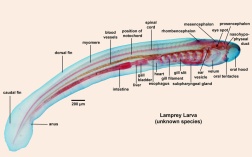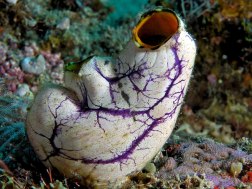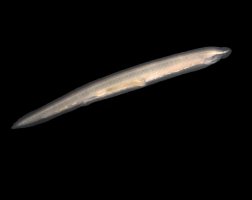All chordates possess, at some point during their larval or adult stages, five synapomorphies, or primary physical characteristics, that distinguish them from all the other taxa. These five synapomorphies include a notochord, dorsal hollow nerve cord, endostyle or thyroid, pharyngeal slits, and a post-anal tail. The name “chordate” comes from the first of these synapomorphies, the notochord, which plays a significant role in chordate structure and movement. Chordates are also bilaterally symmetric, have a coelom, possess a circulatory system, and exhibit metameric segmentation.
In addition to the morphological characteristics used to define chordates, analysis of genome sequences has identified two conserved signature indels (CSIs) in their proteins: cyclophilin-like protein and mitochondrial inner membrane protease ATP23, which are exclusively shared by all vertebrates, tunicates and cephalochordates. These CSIs provide molecular means to reliably distinguish chordates from all other Metazoa.
notochord
a rod-like structure between the alimentary canal and the neural tube, with a supporting function, all chordates have the notochord in the embryo but are retained later in life or throughout life, or Degenerates and is replaced by the spine .
The notochord originates from the dorsal wall of the gastrula during the embryonic period, that is, the notochord mesoderm. After thickening, differentiation, protruding, and finally breaking away from the gastrogut to form the notochord. The notochord is composed of vacuolar-rich notochord cells surrounded by a connective tissue notochordal sheath secreted by notochord cells. The notochord sheath usually consists of two inner and outer layers, a fibrous sheath and an elastic sheath. The notochord cells filled with vacuoles generate turgor and pressure, making the whole notochord both elastic and rigid, thus playing the basic role of bones. In lower chordates, the notochord exists throughout life or is only seen in the larval stage. In higher chordates the notochord appears only during the embryonic period and is replaced by a segmented bony vertebral column when fully developed. The cells that make up the endoskeleton, such as the notochord or spine, grow continuously as the animal body develops. Invertebrates lack endoskeleton such as notochord or spine, usually only the body surface is covered with exoskeleton such as chitin. The appearance of the notochord is of great significance in the history of animal evolution. appears in:
①The notochord (and the spine) constitute the main beam supporting the body, which bears the weight of the body and provides strong support and protection for the internal organs.
②Exercise muscles obtain a strong fulcrum, so that the body will not be shortened or deformed due to muscle contraction during exercise, thus developing towards "larger size". At the same time, the support function of the central axis of the notochord can also enable the animal body to complete directional movement more effectively, and it is more accurate and rapid for active predation and evasion of predators.
③ The formation of the vertebrate skull, the appearance of jaws, and the protection of the central nervous system by the spinal canal are all further perfect developments on this basis.
dorsal tubular nerve cord
The hollow, tubular central nervous system located on the back of the notochord. In vertebrates, the front of the neural tube expands to form the brain, and the back of the brain forms the spinal cord.
Formed by invagination of the ectoderm in the dorsal mid-section of the embryo body. The dorsal neural tube differentiates anteriorly and posteriorly into the brain and spinal cord in higher species. The neurocoele forms the cerebral ventricle in the brain and the centralcanal in the spinal cord. The central part of the nervous system of invertebrates is a solid ventral nerve cord located on the ventral surface of the digestive tract.
The dorsal hollow nerve cord
The dorsal hollow nerve cord is a hollow tube derived from the ectoderm during the embryonic stage of vertebrates. It lies dorsal to the notochord. Thus, it may be seen at the top of the notochord in chordates. This tube is made up of the nerve fibers that ultimately develop into the central nervous system where the brain and the spinal cord are the main constituents. The dorsal hollow nerve cord is protected by the vertebral column.
The nerve cord, though, is not an exclusive feature of chordates. It is also present in other animal phyla. In other animals, it is located either ventral or laterally as opposed to that of chordates that lie dorsal to the notochord.
gill slit
A series of fissures arranged in pairs on both sides of the pharynx, directly or indirectly communicated with the outside world. The gill slits of lower chordates and fish exist throughout their lives, while other vertebrates have gill slits only in the embryonic stage. Derived from ectoderm and endoderm
There are a series of slits arranged in pairs on both sides of the pharynx at the front end of the digestive tract in chordates such as basalis, which directly open on the body surface or indirectly communicate with the outside world through a common opening. These slits are the pharyngeal slits. The gill slits of lower aquatic chordates are present throughout life and are accompanied by vascularized gills. As a respiratory organ, terrestrial higher chordates only have branchial openings in embryonic or larval stages (such as amphibian tadpoles), and eventually die out completely with growth and development. The gills of invertebrates are not in the pharynx, and the organs used for respiration include the pectin gills of molluscs and the limb gills, tail gills, and trachea of arthropods.
Post-Anal Tail
This is a posterior elongation of the body that helps propel aquatic animals in water, provides balance, and is used by some terrestrial vertebrates to attract mates and signal when danger is near. This tail shrinks in humans and other apes into a tailbone during embryonic development.
Circulatory system
Located on the ventral surface of the digestive tract, the circulatory system is closed tube. The heart and aorta of invertebrates are at the back of the digestive tract, and the circulatory system is mostly open tube.
Among the above-mentioned features, the notochord, dorsal neural tube, and pharyngeal branchial slit are the three most important basic features that distinguish chordates from invertebrates. In addition, chordates also have some traits that are also seen in higher invertebrates, such as three germ layers, posterior mouth, existence of secondary body cavity, bilaterally symmetrical system, segmentation of body and certain organs, etc. These commonalities suggest that chordates evolved from invertebrates.




